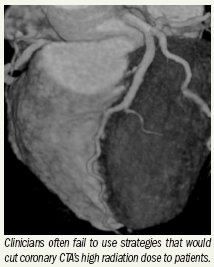Global study sets frameworkfor cardiac CT dose control
Cardiac imagers are accentuating positive aspects of an international multicenter study of cardiac multislice CT imaging, despite a wide variation in the amount of radiation exposure among 1965 patients and the generally infrequent use of available dose reduction strategies.
Cardiac imagers are accentuating positive aspects of an international multicenter study of cardiac multislice CT imaging, despite a wide variation in the amount of radiation exposure among 1965 patients and the generally infrequent use of available dose reduction strategies.

Dr. Jörg Hausleiter of the German Heart Center Munich reported results in the Feb. 4 issue of the Journal of the American Medical Association. He and 10 coauthors found the median dose length product (DLP) to be 885 mGy/cm, a whole-body measurement of absorbed radiation that is equivalent to 12 mSv or 600 chest x-rays. Dose was highly variable among facilities. The per-center median DLP ranged from 331 mGy/cm to 2146 mGy/cm.
Dose reduction strategies worked well where they were applied. Tube current modulation helped reduce DLP by 25% in the 73% of cases where it was applied. Turning down the tube setting to 100 kV from the standard 120-kV setting cut DLP by an average of 46% but was used in only 5% of the cases. Sequential scanning, which exposes patients to radiation only during specific parts of diastole, reduced patient exposure by 78%, but it was used in just 6% of cases.
The trial (PROTECTION I) established for the first time how MSCT clinical protocols are applied with a variety of equipment in differing practice settings, said senior researcher Dr. Stephan Achenbach, director of cardiac imaging research at the University of Erlangen in Germany. About 96% of the exams were performed on 64-slice scanners, and about 4% with 16-slice technology.
Researchers were relieved that the 12 mSv median dose was low enough to avoid stirring controversy, he said.
“This study shows that many sites are examining their patients [using] low doses,” Achenbach said.
Making a comparison between the radiation exposure of one cardiac CT scan and 600 chest x-ray was misleading, he said.
“Chest x-rays these days involve almost no radiation,” he said.
The study establishes a baseline for prudent cardiac CT, said Dr. U. Joseph Schoepf, director of cardiac imaging research at the Medical College of South Carolina.
“The story of learning curves in the adoption of new technology runs like a red thread through this paper,” he said.
In an accompanying JAMA editorial, Dr. Andrew J. Einstein of the Columbia University College of Physicians and Surgeons wrote that the results underscore the need for a patient-specific benefit-risk analysis before performing high-dose cardiac CTA. The potential value of dose-reduction methods should serve as a wake-up call to cardiac CT laboratories that do not routinely use these methods, he said.
Could AI-Powered Abbreviated MRI Reinvent Detection for Structural Abnormalities of the Knee?
April 24th 2025Employing deep learning image reconstruction, parallel imaging and multi-slice acceleration in a sub-five-minute 3T knee MRI, researchers noted 100 percent sensitivity and 99 percent specificity for anterior cruciate ligament (ACL) tears.
The Reading Room: Artificial Intelligence: What RSNA 2020 Offered, and What 2021 Could Bring
December 5th 2020Nina Kottler, M.D., chief medical officer of AI at Radiology Partners, discusses, during RSNA 2020, what new developments the annual meeting provided about these technologies, sessions to access, and what to expect in the coming year.
New Collaboration Offers Promise of Automating Prior Authorizations in Radiology with AI
March 26th 2025In addition to a variety of tools to promote radiology workflow efficiencies, the integration of the Gravity AI tools into the PowerServer RIS platform may reduce time-consuming prior authorizations to minutes for completion.
Strategies to Reduce Disparities in Interventional Radiology Care
March 19th 2025In order to help address the geographic, racial, and socioeconomic barriers that limit patient access to interventional radiology (IR) care, these authors recommend a variety of measures ranging from increased patient and physician awareness of IR to mobile IR clinics and improved understanding of social determinants of health.